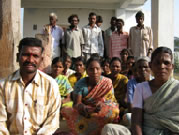It is estimated that over 50% of all disasters are now related to extreme weather events. Because of this, disaster risk reduction should become an integral part of adaptation projects. Community-based disaster risk reduction (CBDRR) holds the same merit that community-based adaptation does: ownership and sustainability. This field guide presents an overview of establishing a CBDRR program in a community.
Conducting a Participatory Capacity and Vulnerability Analysis.
In chapter 2 you conducted in a participatory capacity and vulnerability analysis as part of developing your community-based adaptation project. Use the same resources that you found in that chapter—yet focus the assessment on hazards and disasters. Examples could be floods or extreme weather events such as hurricanes. One of the exercises is to do a participatory map. It is useful is to transfer the information from the map into a larger format on a public wall where everyone in the community can see it and better understand how disasters can impact their village.
| Setting up a Community-Based DRR Committee | |
 |
In chapter 7 you set up a community-based project management committee. You can use the same technique to set up a community-based DRR committee. This committee will be able to coordinate with your NGO and then create long-term associations with government agencies that can continue to support DRR activities. The committee will be in charge of developing a DRR plan—and of coordinating disaster teams. |
Developing a DRR Plan
Developing a DRR plan will include the development of each of the following list of activities and maintaining them in perpetuity. This will involve a plan for consciousness raising among community members about DRR challenges, connecting with an early warning system, the organizing of teams, training them in evacuation and search and rescue, and prioritizing mitigation strategies—and for training community members to implement mitigation activities.
Organization of Teams
Based upon the results of your community’s PVCA, they will have prioritized hazards and disasters. As part of their DRR plan the committee will have prioritized preparedness activities, reduction in risk activities and mitigation activities. If, for example, the type of disaster your community faces necessitates evacuation, an evacuation team should be established that develops a plan to lead the evacuation at the appropriate time. You should do this for each of the major priorities in the plan.
Promotion to Community
Frequently community members don’t have a clear picture of how and why disasters happen. They also may not know how to react when the disaster is building or is already in progress. Workshops and simple posters or how-to cards—without words—need to be developed to help them understand these concepts and to learn that there are things that they can do to reduce the risk caused by disasters, and mitigate the severity of the disasters.
Early Warning Systems
Traditionally, community members have not had warning of when they need to evacuate—and frequently they have left it too long. The government meteorological office may have the capability of, for example, in a potential flood situation, evaluating when water has reached a critical height and have the capability of announcing that a flood is imminent. Communities should form partnerships with these offices and purchase dedicated telephones and alarms.
Evacuation Training
If people need to evacuate, they need to know when to evacuate, they need to know where to go where it’s safe, they need to know what to do with their valuable possessions and assets, they need to know what to take with them, and they need to know what to do when they get to shelter. Capacity building workshops can train community members in each of these—and most importantly—can lead them in practice drills.
Search and Rescue Training
Search and rescue team members learn specific techniques that are safe, and are given simple tools such as lifejackets, safe boats, inner tubes, and flashlights which give them the confidence and the capability to look for a missing person or of rescuing a trapped, elderly or disabled person.
Capacity Building for Disaster Mitigation Activities
There are many things that can be done to mitigate potential disasters. Some, like plantings along the river banks can reduce erosion during a flood season, or the reforestation a watershed can reduce danger from flash floods and are activities that communities can do over the span of time. Capacity building workshops give community members the skill sets that they need to do these activities. Others like relocating houses to higher ground or building bridges may be outside of their purchasing power, but committee members can be trained to develop advocacy campaigns for approaching governments for support for these more major investments.